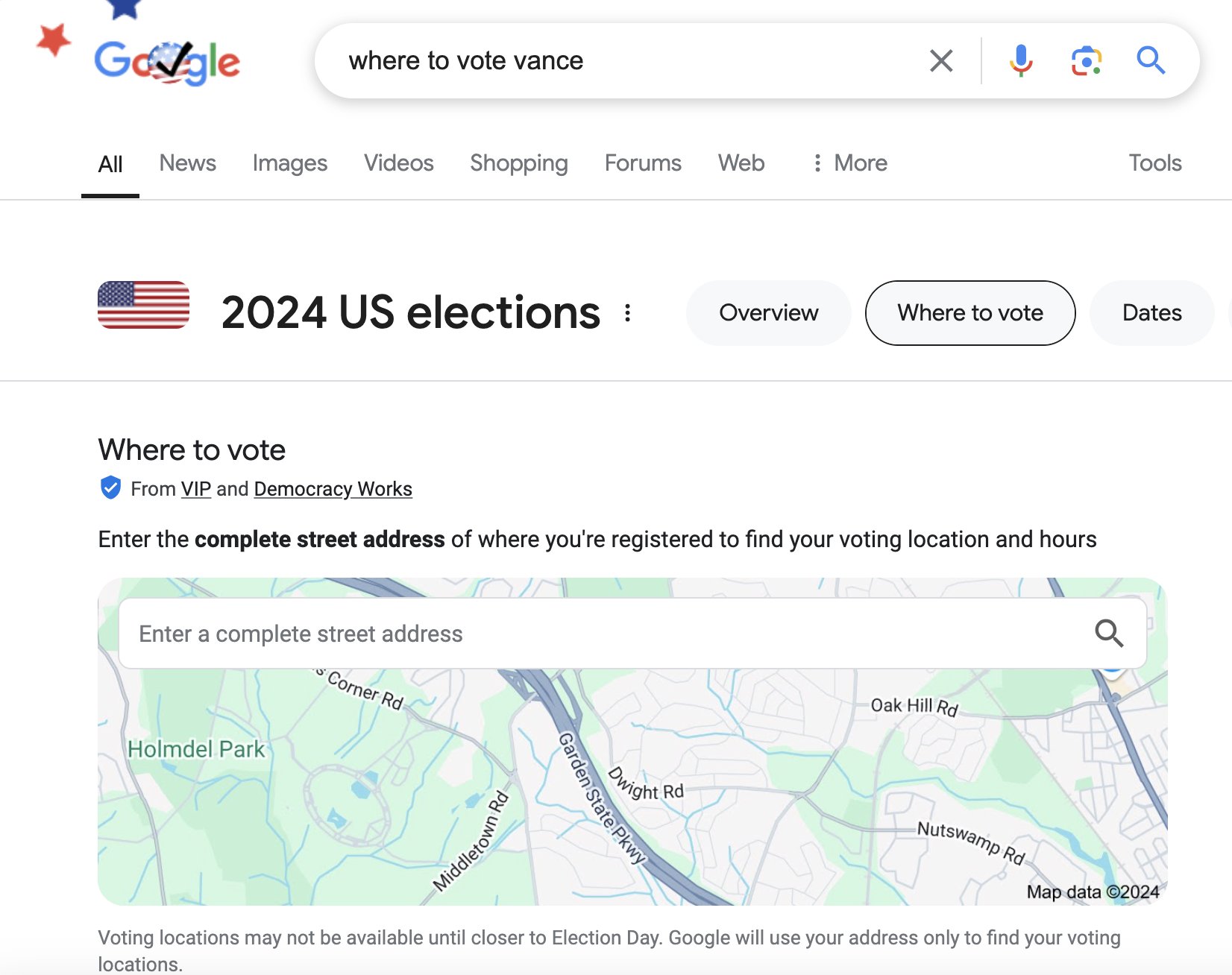Para leer en español, vea esta traducción de El Tiempo Latino.
Quick Take
Social media users alleged bias against former President Donald Trump when a Google search on Election Day for “where to vote” returned an interactive map to find a person’s polling station when including the word “Harris” but not “Trump.” The reason is because “Harris” is a county in Texas, whereas “Trump” is not a location.
Full Story
As millions of Americans were headed to the polls to cast their ballots on Nov. 5, social media accounts were falsely claiming Google was trying to interfere with the election by providing different search results for Vice President Kamala Harris than it did for Trump.
In late October, the company had rolled out a map search result feature, as it had in previous years, to provide voters with locations when they searched for terms such as “where to vote” or “ballot dropboxes.”
It turned out the interactive map, allowing a person to put in their address, also appeared when querying “where can I vote for Harris,” but not when searching “where can I vote for Trump.”

Several social media accounts jumped to the conclusion that the differing search results were an effort by the tech behemoth to swing the election.
“BREAKING: Google shows a ‘Where to Vote’ section with a map for Kamala Harris, but not for Donald Trump,” wrote one influential post on X. “Google is the biggest corporate donor to the Democratic Party.”
X owner Elon Musk, a prominent supporter of Trump, reshared the post, asking, “Are others seeing this too?” He proceeded to post about it two more times within about 30 minutes, including a now-deleted post that read, “This is so messed up.”
But the discrepancy came down to the simple fact that only one candidate has a location-based name. Harris is a county in Texas; Trump is not a location.
Indeed, while we could replicate the results, we also found that we did not get the map result when adding Harris’ first name. We also found that the map appeared when adding a variety of common names that happen to be places: Jones, Davis, Williams, Franklin and Johnson — or when keeping the search terms simple, and just typing “where can I vote.”
Less than an hour after Musk’s reshare, Google had responded and explained the issue.
“The ‘where to vote’ panel is triggering for some specific searches bc Harris is also the name of a county in TX,” the company said in an X post. “Happens for ‘Vance’ too bc it’s also the name of a county. Fix is coming. Note very few people actually search for voting places this way.”
Vance County is in North Carolina.
Google implemented a fix shortly. According to a company blog post, the map search result feature uses information from the Voting Information Project, which is a collaboration between state and local election officials and Democracy Works, a nonpartisan civic technology nonprofit. Google helps fund the project.
As for the claim that Google is “the biggest corporate donor” to Democrats, the company itself can’t contribute money to candidates. Its political action committee contributed a slightly greater percentage of its donations to Republicans in this election cycle, according to OpenSecrets, which tracks political contributions. Individual contributions from the employees of Google parent company Alphabet favored Democrats overall, but the total amount donated ranked 49th among the organizations OpenSecrets tracks.
Musk did reshare Google’s post, adding, “Thanks for the clarification.” A reader’s note was also appended to the original post he had shared. It explained that a variety of location names work, but not “if there is no city / county / state with the same name,” such as Kamala, Trump and Walz.
But even after the explanation, claims of election interference continued to circulate — and proceeded to distort Google’s response into an admission of wrongdoing.
“Google admits to Trump and Harris search engine discrepancy, says ‘fix is coming,’” read one X post. “This is ABSOLUTELY INTERFERING WITH THE US ELECTION.”
In the wee hours of the morning the day after the election — shortly before the Associated Press called the race for Trump — the same account continued to insist on malfeasance.
“Guess what happens to Google once the Trump administration investigates them for election interference?” a post read.
Editor’s note: FactCheck.org does not accept advertising. We rely on grants and individual donations from people like you. Please consider a donation. Credit card donations may be made through our “Donate” page. If you prefer to give by check, send to: FactCheck.org, Annenberg Public Policy Center, P.O. Box 58100, Philadelphia, PA 19102.
Sources
Kitchen, Geordy. “Find voting information on Google Search and Maps.” The Keyword (Google company blog). 21 Oct 2024.
News from Google (@NewsFromGoogle). “The ‘where to vote’ panel is triggering for some specific searches bc Harris is also the name of a county in TX. Happens for ‘Vance’ too bc it’s also the name of a county. Fix is coming. Note very few people actually search for voting places this way.” X. 5 Nov 2024.
News from Google (@NewsFromGoogle). “Update: This is now fixed.” X. 5 Nov 2024.
“PAC Profile: Google Inc.” Open Secrets. Accessed 6 Nov 2024.
“Alphabet Inc.” Open Secrets. Accessed 6 Nov 2024.
Yoon, Robert. “Why AP called Wisconsin and the White House for Donald Trump.” AP. 6 Nov 2024.